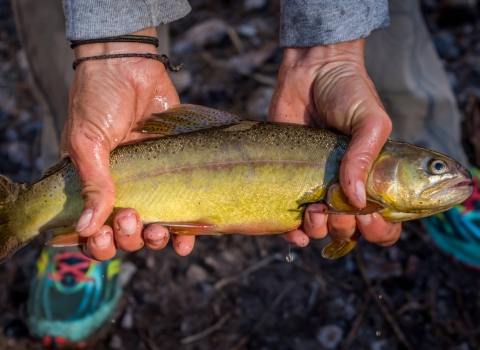Today we announced the selection of four Upper Mississippi River Basin nature-based solutions projects, totaling almost $1.4 million, through President Biden’s Investing in America agenda. This investment is part of a $10 million allocation through the Inflation Reduction Act - the largest climate investment in history - for resiliency and restoration in the Upper Mississippi and Illinois River, to include parts of Illinois, Iowa, Minnesota, Missouri and Wisconsin. These four projects will reduce the risks and associated damages of flood and drought by restoring resilient habitats using nature-based solutions and climate adaptive infrastructure. The projects will also benefit fish and wildlife species and increase access and opportunity for recreational activities such as hunting and fishing.
Through the Bipartisan Infrastructure Law Bipartisan Infrastructure Law
The Bipartisan Infrastructure Law (BIL) is a once-in-a-generation investment in the nation’s infrastructure and economic competitiveness. We were directly appropriated $455 million over five years in BIL funds for programs related to the President’s America the Beautiful initiative.
Learn more about Bipartisan Infrastructure Law and the Inflation Reduction Act, the Department of the Interior is implementing a more than $2 billion downpayment to restore our nation’s lands and waters. In March, the Service announced an investment of more than $120 million from the Inflation Reduction Act to rebuild and restore units of the National Wildlife Refuge System and partnering State Wildlife Management Areas that have been affected by adverse weather events. The investment prioritizes projects that promote coastal resilience and climate adaptation, address invasive species invasive species
An invasive species is any plant or animal that has spread or been introduced into a new area where they are, or could, cause harm to the environment, economy, or human, animal, or plant health. Their unwelcome presence can destroy ecosystems and cost millions of dollars.
Learn more about invasive species threats, and provide for additional data collection needed to support successful natural resource resilience.
These four projects represent a unique opportunity to address important ecosystem restoration needs and are designed to reduce the impacts of climate change climate change
Climate change includes both global warming driven by human-induced emissions of greenhouse gases and the resulting large-scale shifts in weather patterns. Though there have been previous periods of climatic change, since the mid-20th century humans have had an unprecedented impact on Earth's climate system and caused change on a global scale.
Learn more about climate change to an ecosystem which is home to essential wetland and floodplain habitats, and to people who live there.
“We’re pleased that this critical funding is available through the Inflation Reduction Act and that we have the expertise of our team and partners to work collectively to restore and connect these important habitats and increase their resiliency to climate change along the Upper Mississippi River,” said Sabrina Chandler, the Service’s Upper Mississippi River National Wildlife and Fish Refuge Manager.
Upper Mississippi River Basin projects include two on Iowa Department of Natural Resources managed lands, one on Wisconsin Department of Natural Resources managed lands, and one on Illinois Department of Natural Resources managed lands.
- Green Island Wildlife Management Area Floodplain Connectivity and Wetland Restoration (Jackson County, Iowa), $390,000. This project will permanently deconstruct a levee to reconnect a stream back to the floodplain, restoring 30 acres of emergent wetlands and stream channel diversity in a recently acquired, formerly drained agricultural field.
- Pool Slough Wildlife Management Area (Allamakee County, Iowa) $145,000. This project will create or restore 10 acres of emergent floodplain wetland by permanently removing sections of drainage ditch levee to allow water to naturally connect to the floodplain benefiting the 708-acre Pool Slough Wildlife Management Area.
- Lower Chippewa and Black River Confluences Floodplain and Bluffland Habitat Restoration (La Crosse, Trempealeau and Buffalo Counties, Wis.) $500,000. This project will restore and enhance 1500 acres of habitat for eastern massasauga rattlesnake and other floodplain, forest, barrens, in-stream and bluffland species using habitat management strategies that emphasize resilience to climate change. Habitat restoration actions include the introduction of prescribed fire, timber stand improvement, seeding and management of wet meadow, prairie seeding, invasive species management and planting of trees and shrubs to improve climate resiliency for the mosaic of habitats that support many trust resources, including two distinct populations of Eastern Massasauga rattlesnake.
- Old Sny Public Use Area Connectivity Restoration, Upper Mississippi River Pool 22 (Adams County, Ill.) $350,000. This project includes habitats important to fish and wildlife and will enhance the climate resiliency of backwater wetlands and provide overwintering fish habitat. This project will enhance recreational fishing opportunities for local area residents including communities in and near Quincy, Ill.
Through these investments, the Service is working with state partners to complete geographically diverse, large-scale projects that are mutually beneficial for these conservation areas, including projects that benefit underserved communities and Tribal interests. The program supports the Biden-Harris administration’s America the Beautiful Initiative, a decade-long challenge to pursue locally led and voluntary conservation to protect, conserve, connect, and restore our nation’s lands, waters, habitats and wildlife.
Learn more about our Inflation Reduction Act-related efforts.



